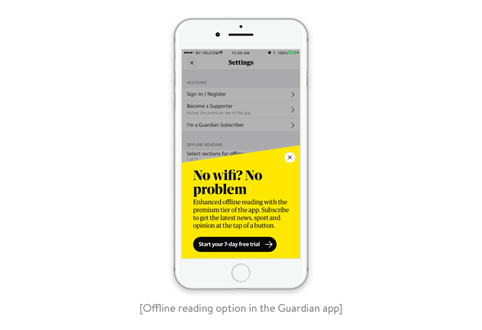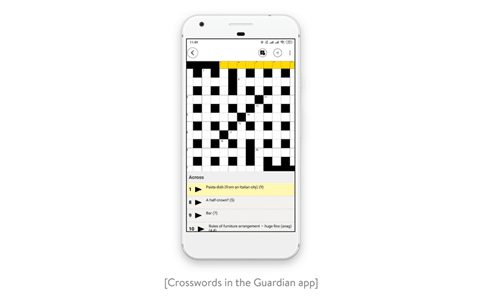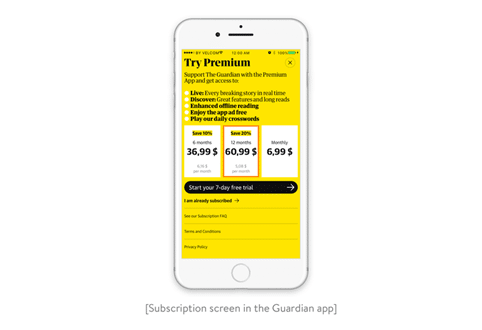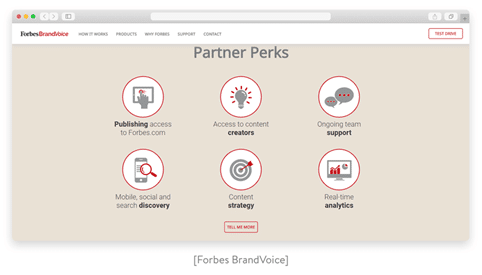Nowadays, we have a lot more news sources than just magazines and newspapers. The whole news industry has grown significantly. You have access to tons of people-created news posts on sources such as Medium. You can create your own selection of news from various websites using aggregators. Or just read social media news feeds like Facebook and Twitter, like most Americans, who also don’t tend to trust official media too much — Forbes states that about 60 percent of American citizens don’t believe media they know about are objective.
But still, people prefer trustworthy sources, such as well-established news agencies (The NY Times, BBC, etc.). News app from such agencies is always promising in terms of income. The Guardian has published a report for 2021 which states that their digital reader revenue has increased 60 percent in comparison to 2020. Statista states that the number of people subscribed to the digital version of the NY Times has reached 5.65 million in 2021. That is why creating a news app is a great choice for anyone looking to attract more audience and make more profit for their news agency.
In this article, we’re going to talk about the biggest challenges that stand before developers of newspaper and magazine applications. We’ll also take a look at ways to deal with them using technological solutions and to widen the audience and make it more loyal, therefore increasing your profits. Also, if you’d like to find out more about the SaaS app development process here is the most useful information. Let’s get to it!
Main challenges of a media outlet

Speaking of the main challenges for online magazines and newspapers, we can highlight the following ones:
- Low engagement rates (sessions are rather short, with few active viewers). Apparently, it is much more comfortable for people to talk about the news on Facebook, Twitter, and other social media than to use a news application or a news website for that.
- Rising reader churn rate due to mistakes in articles. The deadlines can be harsh, and some mistakes will inevitably survive the editing when the outlet is trying to meet those deadlines.
- Media income going down due to the popularity of adblockers. Users get tired of advertisement banners and try to avoid them, focusing on articles.
It is not enough for a news app to aggregate news in order to be successful. The modern audience requires great content, ways to monetize it efficiently, and high engagement levels. If you ignore these requirements, there’s a high chance that your news app will get behind in the industry race pretty quickly. Let’s take a detailed look at how to avoid that.
Recommended for you: Cross-Platform App Development: An Ultimate Guide for 2022.
How to widen your audience and create loyalty?

People tend to talk about the news on social media and popular blogs, instead of visiting your website/application and doing it there — why? You see, social media gives users a reliable way to feel that their social life is active and rich. All their friends are there, their idols are there, all the important news too, along with games and funny videos. Yeah, trying to compete with Facebook or Twitter on their field looks like an uphill battle, but still, there are ways for your app to improve to stand its ground.
Make sure your application is easy to navigate
One thing that social media are usually weak about is structuring their content. Your audience would surely appreciate well-organized content with easy navigation. Ways to achieve it:
- Advanced search filter — search by category, writer, or topic.
- Categorized newsfeeds, hot and most discussed news included.
- Collections of articles and the possibility to save articles for later reading.
Make your news app more social
The more engaging you make your news application, the more people will use it on a regular basis, it works just like social networks. Here are some ways to increase the engagement rate:
- Rating system for content and the possibility to leave comments in threads.
- Follow particular writers or categories of news.
- Quotation possibility for articles.
Also, don’t forget to notify your audience about new content with news notifications and send-outs.
Make the content personalized
There are numerous ways to tailor your news application experience to each particular user using machine learning tech. Solutions like Amazon Personalize provide social filtering that will ensure that your readers get suggestions on the content based on the preferences of people with similar news preferences. You can also use something like SmartNews, a solution predicting interesting topics for a particular reader.
Diversify your content
One particular strength of social media is that they bring really diverse content, audio, and video clips, and live feeds get mixed with long-reads and photo collages. This is something you can introduce to your news application too, providing your viewers with streams of political debates, analytical podcasts, or documentary programs. A fashion-themed online resource can publish makeup guides and commentaries for fashion events.
One application that employs such an approach is Newsy: Video News. The app provides entire news stories within two-minute (or shorter) videos and podcasts.
Virtual reality (VR) is a promising solution for news applications too. Instead of simply reading the news, people can get first-hand experience. Virtual reality lets viewers experience events like protests, conflicts, and sports competitions with advanced immersion. Such a project has been launched by the NY Times: a VR application for news streams, accessible from iOS and Android.
Respond to reader requests and complaints
When you are producing and distributing content, it’s essential to have a person responsible for users’ feedback, which is sometimes not on the news agencies’ agenda. The reason for that is usually budget constraints: some news companies simply can’t afford to hire a person for this position, and sometimes they need more than one. In reality, there’s no need to hire the whole office for this purpose, the assistance of a help center will do.
The BBC, CNN, The NY Times, as well as other big news companies, have a dedicated web resource and a screen inside the application containing all the necessary information about the company and services, as well as FAQs and report issues. A good idea would be to create a special form for users so that they could send feedback and report possible issues. Here’s an example of such a form by the BBC:

Do your best to bring high-quality content
Another important point that journalists still neglect is having someone who manages the reviewing and assessing requests for corrections. An autocorrect feature can be an effective solution to multiple mistakes and corrections.
While articles go through the process of corrections, readers still discover and report mistakes. To deal with fewer such mistakes, you can use the Scribendi proofreading API. This API highlights possible mistakes and suggests corrections before the publication. Grammarly, a popular digital writing assistant launched a beta version of its Text Editor SDK to provide real-time assistance via an API.
Let users enjoy news anywhere and anytime
Say you’ve seen a cool article about new app design trends and want to read it somewhere without access to Wi-Fi (plane flight, perhaps). With social media, you’d have to wait till you found an internet connection. In the case of a news app, however, you can implement an offline mode to make content downloadable for later reading. The Guardian app, for example, provides such a feature:

Give people time killers
You’ve probably tried the Facebook games — they’re really popular right now. A great way to spend 10-15 spare minutes when you have nothing on your hands. You might want to consider adding such games to your application as well. Modern mobile devices can run anything these days, from simple crosswords to shooters.

You may like: Progressive Web Apps (PWA) and Search Engine Optimization (SEO).
How to get more money for your news business?

Back when local news agencies distributed newspapers and magazines at kiosks, supermarkets, post offices, and bookstores, people could purchase a paper copy or subscribe to the newspaper and have it delivered to their porch.
Then everything changed with the internet: more and more people started to prefer reading online to reading on paper. To survive through the era of digitalization, news businesses had to build websites and run banner ads on them. For years, advertising was the main source of income for newspaper and magazine companies.
And here we are today, with people enabling ad blockers and disabling this revenue source. So, what can you do?
Subscriptions
News companies have recently gone back to the subscription model. Most of them have adopted a freemium model, limiting access to their content in different ways.
The Guardian, for instance, doesn’t allow free users to see long-reads, real-time news, and broadcasts. In addition, all free users see ads in the app. But readers who purchase a subscription can enjoy unlimited access to all news content and ad-free reading. The offline mode in the Guardian app is also a feature available with the paid subscription.

Advertising
Traditional digital ads like banners and pop-ups often seem invasive, and users are sick and tired of them. What’s more, many readers have grown so accustomed to ads that they don’t even notice them. That’s why traditional advertising with pay-per-click monetization is no longer profitable. But if you think that mobile advertising is dead, you’re wrong. It’s still a dominant monetization model for news websites and apps.
You can present the ads in an efficient and significant way. Native advertising is one such way to make ads effective. Native ads feel like the part of your content. It offers a smooth reading experience to the visitors and stimulates them to pay attention to it.
The Huffington Post app, for example, runs ads along with its articles. The ads don’t stand out from the news content. The only thing that differentiates ads is a “sponsored” tag and a direct link to a product page. Forbes does this as well with its BrandVoice, a whole marketing and news platform that allows businesses to publish to the same streams as editorial materials, promote their posts, and see analytics on the promoted content.

What else to consider for your news application?

There are some other things you have to be aware of when you decide to build an app for your news business. Let’s see what they are.
Native or hybrid app
Before starting the app development, you’ll have to choose whether your app should be hybrid or native. Hybrid apps might initially seem like a better idea: you create only one version for iOS and Android, which saves a lot of time and finances. However, creating a native app for a single platform, or multiple native apps to cover all platforms has its benefits.:
- better performance for visual and audial content.
- a highly responsive, customized, and user-friendly interface.
- top-class mobile applications protection.
- functions that are specific to the operating system (access to contacts, camera, location, and so on).
- access to all native APIs.
Though you’ll have to invest more in native apps initially, it will pay off in terms of a much lesser number of issues with interface and performance. Moreover, you’ll have fewer security issues, and your content is less likely to get stolen and distributed without your permission.
Content management system
Most likely, you already use a content management system (CMS) for managing articles being uploaded to your site. Such systems manage various text styles, pictures, videos, animations, and audio. The mobile application, however, would require a separate mobile CMS. Giants of the news industry like CNN, the BBC, and The NY Times have their custom CMSs, and they’ve spent a lot of financial resources and a lot of time creating them. You also can create your own CMS if you can afford it or implement a ready solution such as Butter CMS or Directus.
Metered paywall
The metered paywall is similar to the “freemium” principle: it separates all the content you publish into two categories, free and pay-to-view. In the case of a news app, you can get a limited number of articles, like three or four each month. The Washington Post uses such a paywall, which was developed by ARC publishing. Just like with CMS solutions, you can create your own if you have the resources or use a ready solution such as Tecnavia or Pool.
You may also like: 14 Mobile App Development Trends to Keep an Eye on in 2022-2023.
Final words

News companies had to fight for survival after global digitalization picked up momentum, and currently, their main rivals are social networks. Creating a custom news application is a great way to provide user-friendly navigation and better-structured content that’s personalized and diverse at the same time; a perfect tool to win over potential users.
This article is written by Eisele Candace. Eisele has 5 years of experience as a freelance technical writer, specializing in content related to IT technologies (medical, e-prescription software, real estate apps, and so on) and web design. Holder of a master's degree in journalism and public relations. She also completed programming courses in UI / UX design, iOS, and Python in Mansfield, OH. You can follow her on LinkedIn.





